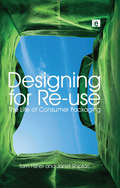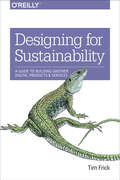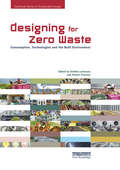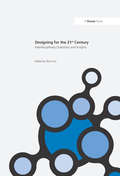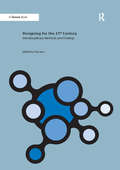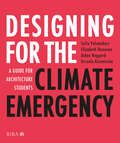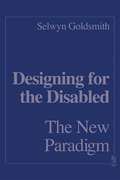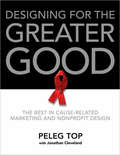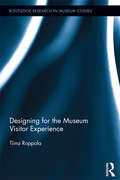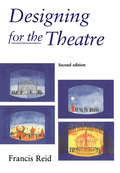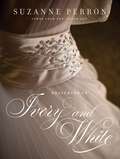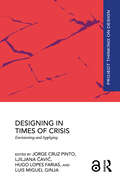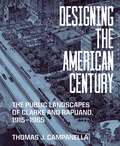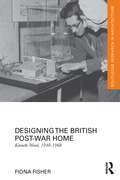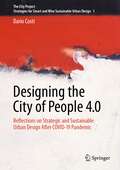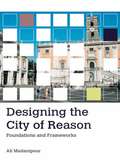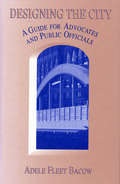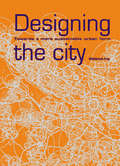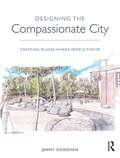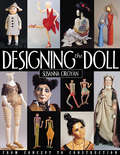- Table View
- List View
Designing for Re-Use: The Life of Consumer Packaging
by Tom Fisher Janet ShiptonPackaging is ephemeral - its purpose is to be 'wasted' once we've removed the product it contains. Whilst we are encouraged to 'reduce, re-use and recycle', Designing for Re-Use proposes that domestic re-use is the 'Cinderella' of this trinity, because it is under researched and little understood. The re-use of packaging could have a significant effect on the quantity of material that enters the waste stream and the energy and consequently carbon that is expended in its production - every re-used item is another item not purchased. The authors demonstrate that we do re-use - but usually despite, rather than because of, the actions of government and designers. The book shows that by understanding the ways in which actions of this sort fit with everyday life, opportunities may be identified to enhance the potential for re-use through packaging design. The authors itemize the factors that affect the re-use of packaging, and analyse the home as a system in which objects are processed. Some of these factors relate to the specifics of the design, including the type of materials used and the symbolism of the branding. Other factors are more obviously social - for instance the effects on re-use of different consumer orientations. The book provides practical guidance from a design perspective, in the context of real-life examples, to provide professionals with vital design recommendations and evaluate how a practice orientated approach to understanding consumers' behaviour is significant for moving towards sustainability through design.
Designing for Sex and Gender Equity (Design Research for Change)
by Isabel ProchnerDrawing on original designer interviews, this book explores how design interventions can and do support sex and gender equity and what barriers still stand in the way. Isabel Prochner not only brings attention to sex and gender problems related to design artifacts but also provides a unique overview of creative design responses to these issues. The case studies and designer interviews provide new information about how designers can address these issues and the challenges they may encounter—whether that’s a lack of anthropometric data, trouble finding investment and business support, or even public resistance. Prochner brings together primary and secondary research and the most contemporary theories on sex, gender, and design. This book will be of interest to scholars working in design studies, sex and gender studies, social design, design for health, industrial design, product design, fashion design, and interaction design.
Designing for Socialist Need: Industrial Design Practice in the German Democratic Republic (Routledge Research in Architecture)
by Katharina PfütznerHow does industrial design operate outside of capitalist consumer culture? Designing for Socialist Need assembles a detailed picture of industrial design practice in the socialist German Democratic Republic (GDR). Drawing on much previously unexplored material from a wide variety of sources, it not only maps out some of the ideological, institutional and economic contexts within which GDR design functioned, it also critically reconstructs the designers’ aims and perspectives in order to argue that they shared a profoundly socially responsible approach to design. By focusing on their ideas and approaches, this volume attends to the previously unacknowledged intellectual and practical richness of GDR design culture and demonstrates that it can provide pertinent insights not only for scholars of GDR history or German design, but also for contemporary design practitioners, theorists and educators with an interest in sustainability in design.
Designing for Sustainability: A Guide to Building Greener Digital Products and Services
by Tim FrickPixels use electricity, and a lot of it. If the Internet were a country, it would be the sixth largest in terms of electricity use. That’s because today’s average web page has surpassed two megabytes in size, leading to slow load times, frustrated users, and a lot of wasted energy. With this practical guide, your web design team will learn how to apply sustainability principles for creating speedy, user-friendly, and energy-efficient digital products and services.Author Tim Frick introduces a web design framework that focuses on four key areas where these principles can make a difference: content strategy, performance optimization, design and user experience, and green hosting. You’ll discover how to provide users with a streamlined experience, while reducing the environmental impact of your products and services.Learn why 90% of the data that ever existed was created in the last yearUse sustainability principles to innovate, reduce waste, and function more efficientlyExplore green hosting, sustainable business practices, and lean/agile workflowsPut the right things in front of users at precisely the moment they need them—and nothing moreIncrease site search engine visibility, streamline user experience, and make streaming video more efficientUse Action Items to explore concepts outlined in each chapter
Designing for Zero Waste: Consumption, Technologies and the Built Environment
by Steffen Lehmann Robert CrockerDesigning for Zero Waste is a timely, topical and necessary publication. Materials and resources are being depleted at an accelerating speed and rising consumption trends across the globe have placed material efficiency, waste reduction and recycling at the centre of many government policy agendas, giving them an unprecedented urgency. While there has been a considerable literature addressing consumption and waste reduction from different disciplinary perspectives, the complex nature of the problem requires an increasing degree of interdisciplinarity. Resource recovery and the optimisation of material flow can only be achieved alongside and through behaviour change to reduce the creation of material waste and wasteful consumption. This book aims to develop a more robust understanding of the links between lifestyle, consumption, technologies and urban development.
Designing for iOS with Sketch
by Sian MorsonDesigning for iOS with Sketch takes you through the process of designing your iOS app using Bohemian Code's Sketch. Sketch is a powerful new design program that is quickly replacing Adobe PhotoShop for many designers designing for mobile apps and the mobile web. This book will introduce you to the program and then take you through the steps of designing your very own app. It includes examples and shortcuts as well as a helpful list of plugins and 3rd party resources that will greatly improve your workflow. What you'll learn What sets Sketch apart from PhotoShop and Illustrator Use Sketch to design a simple iOS app Learn helpful shortcuts to speed up your workflow Get a helpful list of resources from around the web Includes a list of plugins to extend Sketch and make designing more fun Who this book is for Beginning to intermediate iOS app designers who are looking for an alternative to PhotoShop. Table of Contents Chapter 1: Why Sketch? Chapter 2: The Sketch Interface Chapter 3: Shapes and Styles Chapter 4: Symbols Chapter 5: Text and Fonts Chapter 6: Optimizing Your Workflow Chapter 7: Creating a Simple App Chapter 8: Creating an Icon Chapter 9: Exporting Assets for Development Chapter 10: Sketch Resources and Plugins
Designing for the 21st Century: Volume I: Interdisciplinary Questions and Insights
by Tom InnsAs we become familiar with the 21st century we can see that what we are designing is changing, new technologies support the creation of new forms of product and service, and new pressures on business and society demand the design of solutions to increasingly complex problems, sometimes local, often global in nature. Customers, users and stakeholders are no longer passive recipients of design, expectations are higher, and increased participation is often essential. This book explores these issues through the work of 21 research teams. Over a twelve-month period each of these groups held a series of workshops and events to examine different facets of future design activity as part of the UK's research council supported Designing for the 21st Century Research Initiative. Each of these 21 contributions describes the context of enquiry, the journey taken by the research team and key insights generated through discourse. Editor and Initiative Director, Tom Inns, provides an introductory chapter that suggests ways that the reader might navigate these different viewpoints.
Designing for the 21st Century: Volume II: Interdisciplinary Methods and Findings
by Tom InnsAs we become familiar with the 21st century we can see that what we are designing is changing, new technologies support the creation of new forms of product and service, and new pressures on business and society demand the design of solutions to increasingly complex problems, sometimes local, often global in nature. Customers, users and stakeholders are no longer passive recipients of design, expectations are higher, and increased participation is often essential. This book explores these issues through the work of 21 research teams. Over a twelve-month period each of these groups held a series of workshops and events to examine different facets of future design activity as part of the UK's research council supported Designing for the 21st Century Research Initiative. Each of these 21 contributions describes the context of enquiry, the journey taken by the research team and key insights generated through discourse. Editor and Initiative Director, Tom Inns, provides an introductory chapter that suggests ways that the reader might navigate these different viewpoints.
Designing for the Climate Emergency: A Guide for Architecture Students
by Sofie Pelsmakers Aidan Hoggard Urszula Kozminska Elizabeth DonovanWe are in a climate emergency. Architects must be part of the radical change needed. This book guides architecture student to create truly sustainable designs. Demonstrating holistic design approaches through 10 key themes, it guides students through the different stages of the design process in five illustrated chapters. Reflecting the years of study, it provides step-changes towards eventual architecture practice. Unique features include key checklists, case studies, student examples and an extensive glossary.
Designing for the Disabled: The New Paradigm
by Selwyn GoldsmithSelwyn Goldsmith's Designing for the Disabled has, since it was first published in 1963, been a bible for practising architects around the world. Now, as a new book with a radical new vision, comes his Designing for the Disabled: The New Paradigm.Goldsmith's new paradigm is based on the concept of architectural disability. As a version of the social model of disability, it is not exclusively the property of physically disabled people. Others who are afflicted by it include women, since men customarily get proportionately four times as many amenities in public toilets as women - and women have to queue where men do not - and those with infants in pushchairs, because normal WC facilities are invariably too small to get a pushchair and infant into.To counter architectural disability, Goldsmith's line is that the axiom for legislation action has to be 'access for everyone' - it should not just be 'access for the disabled', as it presently is with the Part M building regulation and relevant provisions of the 1995 Disability Discrimination Act. In a 40-page annex to his book he sets out the terms that a new-style Part M regulation and its Approved Document might take, one that would cover alterations to existing buildings as well as new buildings. But architects and building control officers need not, he says, wait for new a legislation to apply new practical procedures to meet the requirements of the current Part M regulation; they can, as he advises, act positively now.This is a book which will oblige architects to rethink the methodology of designing for the disabled. It is a book that no practising architect, building control officer, local planning officer or access officer can afford to be without.
Designing for the Greater Good
by Peleg Top Jonathan ClevelandThis first-ever book of its kind, Designing for the Greater Good, features hundreds of illustrated examples of the best nonprofit and cause-related design worldwide, plus 24 inspiring case studies and insights into great nonprofit branding campaigns. A comprehensive resource for designers, creative professionals, marketers, corporate communications departments and nonprofit leaders, this book showcases work from a variety of sectors including Family and Community, Animal Causes, Health, Human Rights, Environmental Awareness, Spirituality, and the Arts. The 24 case studies feature interviews with the designers for such campaigns as the Avon Walk for Breast Cancer, The Hurricane Katrina Poster Project and Get London Reading. Materials presented in Designing for the Greater Good include: cause-specific campaigns and case studies; logos and branding for nonprofits; websites, posters, brochures, advertising, and marketing materials for cause-related events and nonprofits; packaging; invitations for fundraisers and events.
Designing for the Museum Visitor Experience (Routledge Research in Museum Studies #5)
by Tiina RoppolaExhibition environments are enticingly complex spaces: as facilitators of experience; as free-choice learning contexts; as theaters of drama; as encyclopedic warehouses of cultural and natural heritage; as two-, three- and four-dimensional storytellers; as sites for self-actualizing leisure activity. But how much do we really know about the moment-by-moment transactions that comprise the intricate experiences of visitors? To strengthen the disciplinary knowledge base supporting exhibition design, we must understand more about what ‘goes on’ as people engage with the multifaceted communication environments that are contemporary exhibition spaces. The in-depth, visitor-centered research underlying this book offers nuanced understandings of the interface between visitors and exhibition environments. Analysis of visitors’ meaning-making accounts shows that the visitor experience is contingent upon four processes: framing, resonating, channeling, and broadening. These processes are distinct, yet mutually influencing. Together they offer an evidence-based conceptual framework for understanding visitors in exhibition spaces. Museum educators, designers, interpreters, curators, researchers, and evaluators will find this framework of value in both daily practice and future planning. Designing for the Museum Visitor Experience provides museum professionals and academics with a fresh vocabulary for understanding what goes on as visitors wander around exhibitions.
Designing for the Theatre (Stage And Costume Ser.)
by Francis ReidNow in its second edition, Designing for the Theatre has established itself as the authoritative introduction to the processes of design for the theatre. Covering the contribution which can be made by costume, sets, props and lighting to a stage production, the author explains the purpose and process involved in their design. Included in this second edition are new photographs and drawings illustrating some of the most exciting and diverse current trends in stage design.
Designing in Ivory and White: Suzanne Perron Gowns from the Inside Out (Southern Literary Studies)
by Suzanne Perron Brian Baiamonte Jason Cohen Susan LangenhennigThe name "Suzanne Perron" is synonymous with exquisite detail. Her expertly tailored gowns -- worn at the elaborate balls of Mardi Gras and down the aisle at New Orleans weddings -- draw from the legacy of couture design. After years working alongside Vera Wang, Carolina Herrera, Anna Sui, and Ralph Rucci in New York, Louisiana native Perron returned home in 2005 to open her own custom design business, specializing in once-in-a-lifetime gowns for brides, debutantes, and Mardi Gras royalty. Designing in Ivory and White captures the rise of this talented designer, from her first Singer sewing machine to her success on Seventh Avenue to her post-Katrina move to a city in need of "something beautiful," as well as her design technique and meticulous craft. In addition to her personal story, Perron shares her process from the inside out, including: methods for creating crinolines and foundations; using draping and pattern making to transform a sketch into a three-dimensional form; manipulating fabric into pleats, pintucks, and folds; and hand sewing intricate beading, lace, embroidery, and flawless hems.Her techniques and breathtaking artistry are realized through a showcase of sixteen Suzanne Perron designs. Full-length and detail shots illustrate Perron's gorgeous silhouettes and masterful handwork. Each gown also has a story that illuminates the client experience from the first sketch to the final fitting.Designing in Ivory and White serves as a testament to the ambition and skill required to design unique dresses, and will provide inspiration for independent designers, sewing hobbyists, and all who admire couture fashion.
Designing in Times of Crisis: Envisioning and Applying (Project Thinking on Design)
by Jorge Cruz Pinto Ljiljana Čavić Hugo Lopes Farias Luis Miguel GinjaDesigning in Times of Crisis offers insights, visions, and strategies for architects and urban designers to question and respond to the crises and challenges of the contemporary anthropocentric world. The book highlights the urgency of addressing global crises and encourages architects and urban designers to consider new approaches related to gender equity, city ethics, and fundamental human rights. It promotes the adoption of sustainable practices that heed the social, economic, and environmental impacts of their work, particularly focusing on Portuguese and Brazilian contexts.The book fosters new thinking and practices to provide a comprehensive overview of the challenges and opportunities facing contemporary architecture and urban design. It investigates how these disciplines can adapt to the fluidity of the digital age, respond to climate change, and embrace social justice, all while maintaining a commitment to innovation and sustainability. The book is divided into two parts: “Envisioning” and “Applying”. The first explores various urban and architectural proposals triggered by climate change and contemporary social issues. The second focuses on different experimentations in architectural and urban design, building techniques, dwelling, and teaching during the COVID-19 pandemic, as well as citizenship formation.This timely research is relevant for students, researchers, and practitioners interested in architecture, urban planning, and sustainable design.
Designing the American Century: The Public Landscapes of Clarke and Rapuano, 1915–1965
by Thomas J. CampanellaA richly illustrated look at the lives and collaborations of two unsung giants of American landscape and urban designGilmore D. Clarke and Michael Rapuano were the foremost spatial designers of the American century. Their vast portfolio of public landscapes propelled the legacy of Frederick Law Olmsted and Calvert Vaux into the motor age, touching the lives of millions and changing the face of the nation. Designing the American Century recovers the forgotten legacy of Clarke and Rapuano, whose parks and parkways, highways and housing estates helped modernize—for better or worse—the American metropolis.With the patronage of public-works titan Robert Moses, Clarke and Rapuano transformed New York over a span of fifty years, revitalizing the city&’s immense park system but also planning expressways, public housing, and urban renewal projects that laid waste to entire sections of the city. In this groundbreaking work, Thomas J. Campanella describes how Clarke and Rapuano helped create some of the metropolitan region&’s most iconic landscapes, from the Central Park Zoo and Conservatory Garden to the Henry Hudson Parkway and Riverside Park, Jones Beach, the Palisades and Taconic State Parkways, and the Brooklyn Heights Promenade. He shows how they left their mark far beyond Gotham as well, with projects as diverse as Yellowstone&’s Mammoth Hot Springs, the Mount Vernon Memorial Highway, site plans for the Pentagon and CIA headquarters, and Montreal&’s Olympic Park.Richly illustrated with a wealth of previously unpublished drawings, plans, and photographs, Designing the American Century fills one of the last major gaps in the history of American urbanism.
Designing the British Post-War Home: Kenneth Wood, 1948-1968 (Routledge Research in Architecture)
by Fiona FisherIn Designing the British Post-War Home Fiona Fisher explores the development of modern domestic architecture in Britain through a detailed study of the work of the successful Surrey-based architectural practice of Kenneth Wood. Wood’s firm is representative of a geographically distinct category of post-war architectural and design practice - that of the small private practice that flourished in Britain’s expanding suburbs after the removal of wartime building restrictions. Such firms, which played an important role in the development of British domestic design, are currently under-represented within architectural histories of the period. <P><P> The private house represents an important site in which new spatial, material and aesthetic parameters for modern living were defined after the Second World War. Within a British context, the architect-designed private house remained an important ‘vehicle for the investigation of architectural ideas’ by second generation modernist architects and designers. <P><P> Through a series of case study houses, designed by Wood’s firm, the book reconsiders the progress of modern domestic architecture in Britain and demonstrates the ways in which architectural discourse and practice intersected with the experience, performance and representation of domestic modernity in post-war Britain.
Designing the City of People 4.0: Reflections on strategic and sustainable urban design after Covid-19 pandemic (The City Project #1)
by Dario CostiThis book collects a set of reflections concerning the planning of contemporary cities by urban design, with a special emphasis on some needs and shortcomings emerged during the coronavirus pandemic. With the ultimate goal of designing accessible, inclusive and welcoming green cities, it discusses the urgent need for new systems of public spaces across the city, together with alternative solutions for individual mobility (especially slow mobility) and social interaction. It is intended for a broad readership, including designers, engineers, architects, social scientists, stakeholders, and public administrators, who deal with various aspects of the realization of the City 4.0.
Designing the City of Reason: Foundations and Frameworks
by Ali MadanipourWith a practical approach to theory, Designing the City of Reason offers new perspectives on how differing belief systems and philosophical approaches impact on city design and development, exploring how this has changed before, during and after the impact of modernism in all its rationalism. Looking at the connections between abstract ideas and material realities, this book provides a social and historical account of ideas which have emerged out of the particular concerns and cultural contexts and which inform the ways we live. By considering the changing foundations for belief and action, and their impact on urban form, it follows the history and development of city design in close conjunction with the growth of rationalist philosophy. Building on these foundations, it goes on to focus on the implications of this for urban development, exploring how public infrastructures of meaning are constructed and articulated through the dimensions of time, space, meaning, value and action. With its wide-ranging subject matter and distinctive blend of theory and practice, this book furthers the scope and range of urban design by asking new questions about the cities we live in and the values and symbols which we assign to them.
Designing the City: A Guide For Advocates And Public Officials
by Adele Fleet BacowWritten in a clear and engaging style, Designing the City is a practical manual for improving the way communities are planned, designed, and built. It presents a wealth of information on design and decision-making, including advice on how citizens and activists can make their voices heard, and numerous examples of effective strategies for working with all parties involved in neighborhood and community development. It highlights proven models and strategies to help communities: *establish unique and productive partnerships with public works and transportation departments *develop resources through grant programs *broaden expertise, perspective, and constituency *create new and enduring models for effective action *educate participants and consumers of the design and development process
Designing the City: Towards a More Sustainable Urban Form
by Hildebrand FreyDesigning the City looks at current urban problems in cities and demonstrates how effective urban design can address social, economic and environmental issues as well as the physical planning at local level. The book is highly visual and illustrates the topic with a variety of sketches, line drawings, axonometrics and models. The author draws upon the valuable experience gained by the City of Glasgow and compares its solutions - successful and less successful - with projects in a variety of European countries.
Designing the Compassionate City: Creating Places Where People Thrive
by Jenny DonovanDesigning the Compassionate City outlines an approach to urban design that is centred on an explicit recognition of the inherent dignity of all people. It suggests that whether we thrive or decline—as individuals or as a community—is dependent on our ability to fulfil the full spectrum of our needs. This book considers how our surroundings help or hinder us from meeting these needs by influencing both what we can do and what we want to do; either inspiring us to lead healthy, fulfilled lives or consigning us to diminished lives tainted by ill health and unfulfilled potential. Designing the Compassionate City looks at how those who participate in designing towns and cities can collaborate with those who live in them to create places that help people to accumulate the life lessons, experiences and achievements, as well as forge the connections to meet their needs, to thrive and to fulfil their potential. The book explores a number of inspiring case studies that have sought to meet this challenge and examines what has worked and what hasn’t. From this, some conclusions are drawn about how we can all participate in creating places that leave a lasting legacy of empowerment and commitment to nurturing one another. It is essential reading for students and practitioners designing happier, healthier places.
Designing the Complex City: A Systemic Approach to Spatial Design
by Elena PorquedduHow can designers address the emergent self-organizing nature of complex urban environments? Designing the Complex City highlights how both an excess and a lack of design control might contrast the lively complexity of cities, their adaptive and evolutionary capacity. By using key concepts from systems thinking, complexity sciences, life sciences, cognitive sciences, and social sciences, the book frames a systemic spatial design approach aimed at enhancing the potential of different spatial design disciplines to navigate place-specific emergent transformations without overdetermining their formal outcome. A range of heterogeneous case studies, developing at different scales, show how embracing a design approach that is embodied, open-ended, contextually responsive, incremental and adaptive does not question the relevance of designers’ specific skills in shaping the physical structure of cities; it may rather increase their potential to effectively intervene in complex adaptive cycles of urban decay and self-regeneration.Designing the Complex City provides insights for students, researchers, and academics in architecture, interior design, urban and landscape design, planning theory, and urban studies. It is essential reading for all designers who seek to proactively and meaningfully intervene in spontaneous socio-spatial dynamics.
Designing the Creative Child: Playthings and Places in Midcentury America (Architecture, Landscape and Amer Culture)
by Amy F. OgataThe postwar American stereotypes of suburban sameness, traditional gender roles, and educational conservatism have masked an alternate self-image tailor-made for the Cold War. The creative child, an idealized future citizen, was the darling of baby boom parents, psychologists, marketers, and designers who saw in the next generation promise that appeared to answer the most pressing worries of the age. Designing the Creative Child reveals how a postwar cult of childhood creativity developed and continues to this day. Exploring how the idea of children as imaginative and naturally creative was constructed, disseminated, and consumed in the United States after World War II, Amy F. Ogata argues that educational toys, playgrounds, small middle-class houses, new schools, and children&’s museums were designed to cultivate imagination in a growing cohort of baby boom children. Enthusiasm for encouraging creativity in children countered Cold War fears of failing competitiveness and the postwar critique of social conformity, making creativity an emblem of national revitalization.Ogata describes how a historically rooted belief in children&’s capacity for independent thinking was transformed from an elite concern of the interwar years to a fully consumable and aspirational ideal that persists today. From building blocks to Gumby, playhouses to Playskool trains, Creative Playthings to the Eames House of Cards, Crayola fingerpaint to children&’s museums, material goods and spaces shaped a popular understanding of creativity, and Designing the Creative Child demonstrates how this notion has been woven into the fabric of American culture.
Designing the Doll: From Concept to Construction
by Susanna OroyanThe author of Anatomy of a Doll “gives us a gift by distilling the spirits found in doll/figure art . . . then explains the fundamentals to pave the way” (Barbara Campbell, editor of Soft Dolls & Animals!).Advance your dollmaking skills with this in-depth guide by master-dollmaker Susanna Oroyan! Susanna introduces you to her concept of “imaginative engineering” with a collection of design directions and technical processes that will help your ideas translate into reality.Expands on concepts presented in Anatomy of a Doll and Fantastic Figures.Covers a wide variety of construction methods, such as applications of wire armature in body construction, general concepts of mold making, sculpture mechanics, in-depth discussion of jointed figures, and methods of assembling your doll.More than 250 full-color photos of dolls from 130 of the world’s top doll artists. Over 200 detailed illustrations.Explains elements of design, such as focal point, scale, harmony, style, and the use of color, texture, and pattern. Learn techniques of proportion for working with the human figure.An excellent technical resource and reference book that will teach you how to develop ideas, then construct advanced art figures or dolls.“The doll world has only just recovered from the excitement of having Anatomy of a Doll which showed us what was possible. Now we can learn to get it with this new effort, the fabulous Designing the Doll. Thank you, Susanna, where would we be without you?” —Elinor Peace Bailey, author of Storytelling with Dolls“Demystifies the creation of dolls by offering techniques, basic construction and some very good thoughts on design . . . Filled with diagrams and color photos of dolls from some of the top contemporary doll-makers, inspiration is on every page.” —Polymer Clay
